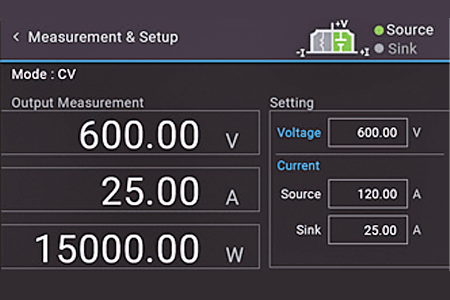#statusMessage#
Do you want to start the compare now?

Here you will find a wide variety of laboratory power supplies, AC sources and DC loads for use in laboratories, development, test benches, production, battery testing and e-mobility / automotive applications. Power supplies and loads are available as benchtops in 19-inch format, with power levels between 10 W and 30 kW, or as ready-to-use systems with power levels up to 1.92 megawatts.
Power supply units (PSUs) are essential for powering everyday devices such as smartphones, laptops, and kitchen appliances. However, when electronic devices require different voltage and current levels than those provided by the standard power grid, a suitable power supply becomes indispensable.
Both the output voltage and the maximum output current of power supplies can be fixed or variable. Laboratory power supplies, also known as bench power supplies, offer enhanced functionality and versatility, making them suitable for professional environments like electronic development, testing systems, and service areas. They are also utilized in amateur electronics projects and academic institutions.
In measurement technology, power supplies are primarily categorized into two types: linear regulated power supplies and switching power supplies.
This type of power supply includes a transformer that converts the input voltage to the required secondary voltage. The subsequent module produces a rectified voltage, which is then regulated to the desired DC voltage by a linear regulator. The advantage of this method is the minimal interference and low ripple in the output voltage. However, this design increases the weight and negatively impacts efficiency.
Switching power supplies differ fundamentally from linear regulated power supplies. They achieve higher efficiency, ranging from 70% to over 90%, making them ideal for high-power applications. This is accomplished through step-up or step-down converters operating at high frequencies between 10 kHz and 100 kHz.
Ferrite core inductors can further enhance the efficiency of the entire circuit. If the output voltage is higher than the input voltage, a boost converter is used; if lower, a buck converter is employed.
The downside of this concept is the switching noise, which manifests as disturbances or noise in the DC output voltage. The quality of each power supply is determined by the subsequent filter used to smooth the output voltage. To meet higher requirements, linear regulators are often connected downstream of these switching power supplies.
Linear regulated power supplies are becoming less common. Even mobile phone chargers now use switching power supplies. The weight difference is noticeable even in these small power supplies. Nevertheless, linear regulated power supplies are still in demand due to their low ripple, especially in laboratory applications.
Voltage, current, and power are the most critical factors when selecting a new power supply. Our product range includes power supplies with output voltages from 0 V to 12 kV.
The available output power is the product of output voltage and output current. Some devices have limitations that require the full output power across the entire output voltage range.
The output power of our laboratory power supplies ranges from approximately 25 W to 15 kW. Some manufacturers allow multiple devices to be connected in parallel, enabling output power up to 150 kW. For comparison, a single-family home can provide about 5 kW of heating power each winter.
A laboratory power supply is a more powerful and versatile power supply, primarily used in professional settings such as the development and testing of electronic products. They are also used in amateur electronics and in education and research at universities. Laboratory power supplies are used to power modules or circuits during development, production, or testing.
Power supplies can be connected in series or parallel, provided they have appropriate control inputs. Some manufacturers allow up to 10 power supplies to be connected in parallel, delivering output power up to 150 kW. When turning on the power supply, ensure the output voltage is free from noise to prevent severe short circuits due to voltage breakdown. Typically, only two devices can be connected in series.
Most power supply elements can be programmed, including output voltage, current, and power, as well as parameters like maximum voltage, current, and power limits to protect the device under test. For some devices, inrush current and voltage can be determined based on the time curve.
The output variable can also be controlled by a given function or curve via an integrated arbitrary generator, function generator, or an analog input channel. Arbitrary or function generators can be integrated into the power supply or connected to the analog input.
Most laboratory power supplies offer interfaces like GPIB, LAN, USB, RS232, RS485, etc. This allows them to be controlled in automated test systems or production environments through automatic program sequences. This can also be used to control and change the output values of the power supply. Use cases include gradually reducing the supply voltage of the device under test to determine when it fails due to insufficient supply voltage.
Based on the descriptions of the various power supply types, consider the following criteria when selecting your new power supply:
When selecting and purchasing a power supply, it's essential to understand the specifications provided in the datasheet to choose the appropriate device.
Several criteria are used to evaluate a power supply, each describing a different aspect of its performance. The importance of each factor varies depending on the application.